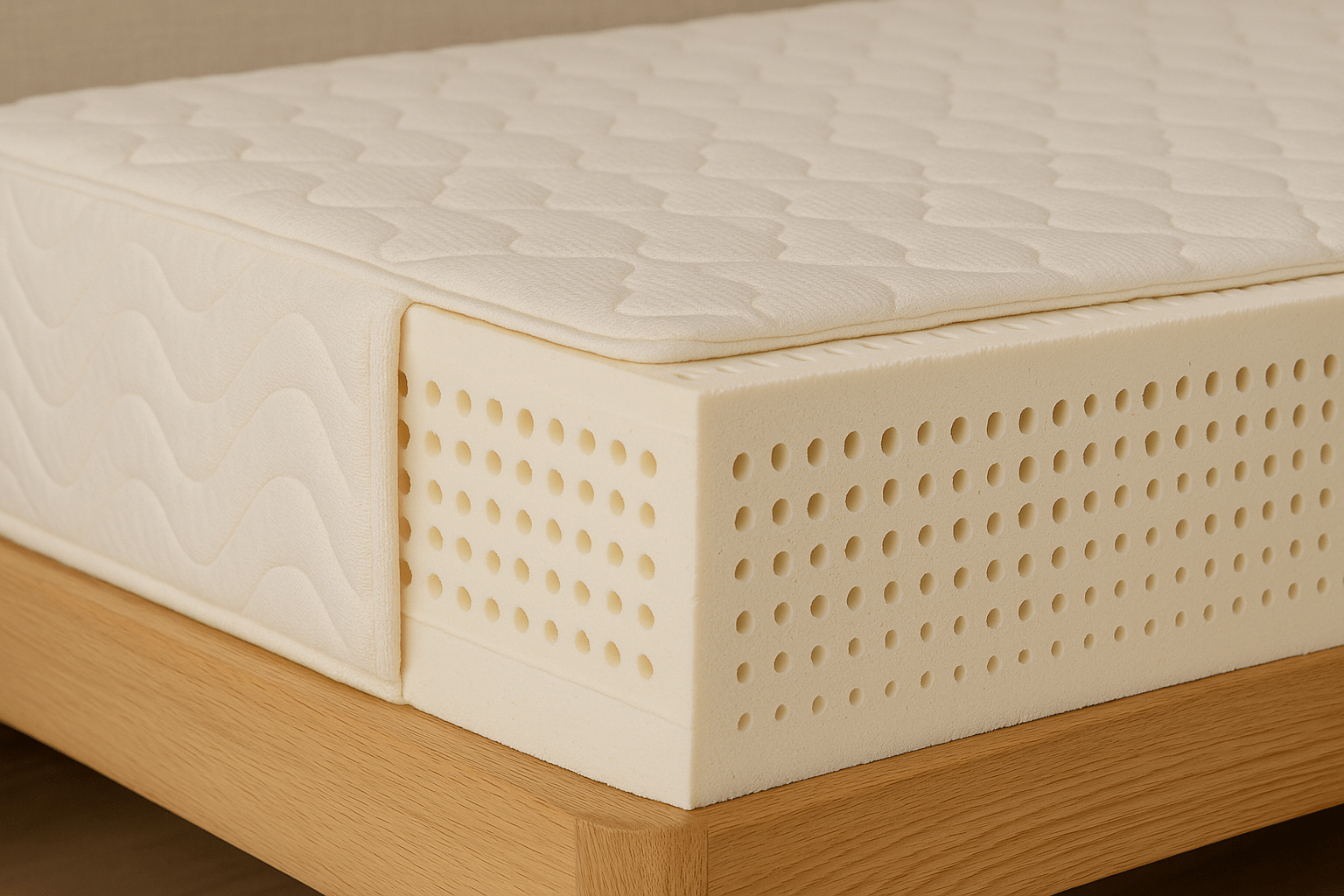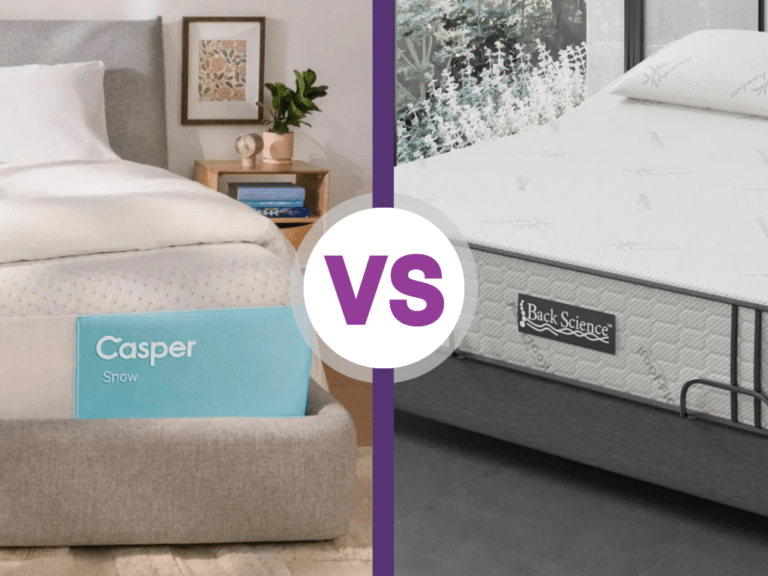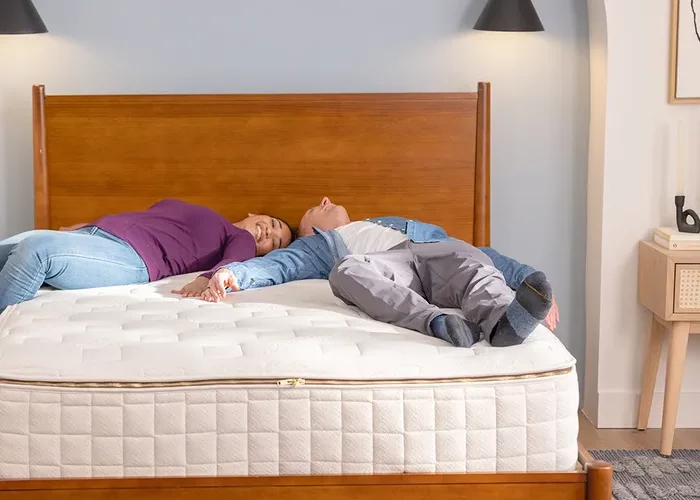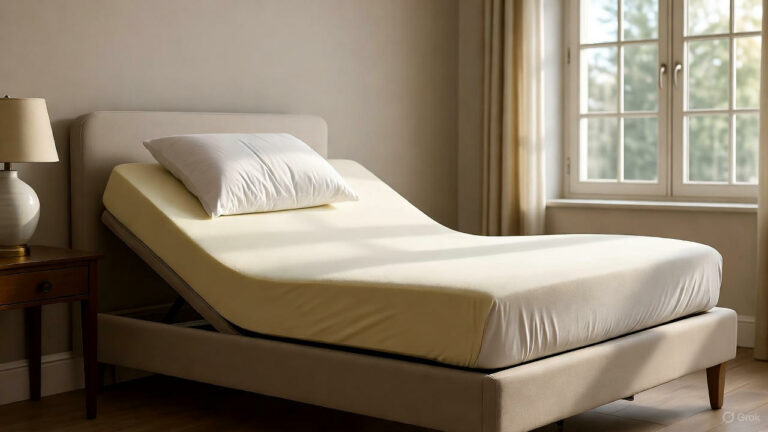
Debunking Myths, Exploring Precautions, and Why Latex is Best
Natural latex mattresses are often misunderstood—especially when it comes to allergies. This article breaks down the facts, explaining that true latex allergies stem from specific proteins removed during the Dunlop and Talalay purification processes. The result? A highly hypoallergenic, durable, and eco-friendly sleep surface. With certifications like OEKO-TEX®, GOLS, eco-INSTITUT, and GREENGUARD Gold, natural latex mattresses offer exceptional comfort, breathability, and longevity—outperforming traditional foam and spring beds in nearly every category.
Natural Latex Mattresses Are Among The Most Hypoallergenic Sleep Surfaces
If you’ve ever shopped for a mattress, you’ve likely encountered the dizzying array of options: memory foam, innerspring, hybrid, and latex. Natural Latex mattresses often get a bad rap, especially when the word “allergy” enters the conversation. Many people assume that anything labeled “latex” must trigger sneezing fits or skin rashes, thanks to associations with latex gloves or balloons. But here’s the spoiler: natural latex mattresses are among the most hypoallergenic sleep surfaces available, and the allergy reputation is largely undeserved.
Part 1: The Latex Allergy Myth—Separating Fact from Fiction
What Actually Causes Latex Allergies?
Latex allergies are real, but they’re protein-specific. The culprit is a group of proteins found in the sap of the Hevea brasiliensis rubber tree, the source of natural latex. When these proteins come into direct contact with mucous membranes or broken skin—think healthcare workers wearing powdered latex gloves for hours—the immune system can mount an IgE-mediated response. Symptoms range from contact dermatitis to, in rare cases, anaphylaxis.
Here’s the critical distinction: mattress-grade latex is processed to remove nearly all of these allergenic proteins. The two primary methods—Dunlop and Talalay—both involve vulcanization (heating with sulfur) and extensive washing. In Talalay latex, the process includes a vacuum expansion and freeze cycle, followed by five separate rinse cycles that flush out proteins, soaps, and curing agents. Independent lab tests (like those from Oeko-Tex or Eco-Institut) routinely show protein levels below 0.1 micrograms per gram—far below the threshold for triggering reactions in sensitized individuals.
Key Stat: The American Latex Allergy Association estimates that only 0.1–1% of the general population has a true latex allergy, and mattress contact does not provoke systemic reactions in these individuals due to minimal protein exposure.
Why the Confusion Persists
- Synthetic Latex Mislabeling: Some brands market “synthetic latex” (actually styrene-butadiene rubber, or SBR) as “latex-free” while natural latex gets painted with the same brush.
- Dust Mites, Not Latex: Many “latex allergy” complaints are actually reactions to dust mite allergens that accumulate in any mattress over time. Latex’s open-cell structure and natural antimicrobial properties (more on this later) make it less hospitable to mites than foam or fiber-filled mattresses.
- Cross-Contamination Fears: Consumers worry about trace proteins from factory equipment. Reputable manufacturers use dedicated molds and separate production lines for natural latex to prevent this.
Bottom Line: If you’re allergic to latex gloves, consult an allergist before purchasing—but for 99% of shoppers, latex mattresses pose no greater risk than any other material.
Part 2: How Latex Mattress Companies Ensure Purity and Safety
Making a latex mattress isn’t like pouring memory foam into a mold and calling it a day. The journey from tree sap to bedroom involves multiple purification stages designed to eliminate impurities, proteins, and off-gassing compounds.
Step-by-Step: The Cleaning Process
| Stage | Dunlop Method | Talalay Method | Purpose |
|---|---|---|---|
| Sap Collection | Tapped from trees, mixed with natural preservatives | Same | Prevent coagulation |
| Pre-Vulcanization | Whipped into foam, poured into molds | Whipped, partially expanded in vacuum | Create cell structure |
| Vulcanization | Baked at 220–240°F with sulfur | Frozen at -20°F, then baked | Cross-link rubber molecules for durability |
| Washing | 1–2 rinse cycles (10–15 minutes each) | 5 rinse cycles (up to 45 minutes total) | Remove proteins, soaps, residual chemicals |
| Drying | Air-dried or low-heat ovens | High-heat baking to set structure | Eliminate moisture that could foster mold |
After washing, slabs are steam-cleaned or ozone-treated to kill any residual microbes. Some brands (like Pure Green or Sleep On Latex) go further with charcoal filtration of rinse water to ensure zero chemical carryover.
Third-Party Certifications: Your Assurance
- Oeko-Tex Standard 100: Tests for 100+ harmful substances, including allergenic proteins.
- GOLS (Global Organic Latex Standard): Requires ≥95% certified organic latex; caps protein content.
- Eco-Institut: Detects VOCs and allergens down to parts-per-billion levels.
- GREENGUARD Gold: Ensures low emissions for sensitive groups (children, elderly).
Pro Tip: Ask for the Certificate of Analysis (CoA) from the latex supplier (e.g., Latexco or Arpico). It lists exact protein and nitrosamine levels.
Part 3: Latex vs. Standard Mattresses—Benefits That Last a Lifetime
Let’s pit natural latex against two common alternatives: polyurethane memory foam and pocketed coil innerspring mattresses. We’ll evaluate across durability, comfort, health, temperature regulation, and cost over time.
1. Durability & Longevity
| Material | Average Lifespan | Compression Set (Sagging) | Warranty |
|---|---|---|---|
| Natural Latex | 15–25 years | <5% after 10 years | 20–25 years (pro-rated) |
| Memory Foam | 7–10 years | 15–30% after 5 years | 10 years |
| Innerspring | 5–8 years | Coil fatigue; edge collapse | 10 years |
Latex’s cross-linked molecular structure resists permanent indentation. A 2019 study in Journal of Applied Polymer Science found Talalay latex retained 92% of its original height after 100,000 compression cycles—equivalent to ~27 years of nightly use.
2. Pressure Relief & Spinal Alignment
Latex offers progressive resistance: soft where you need cushion (shoulders, hips) and firm where you need support (lumbar). Unlike memory foam, which “sinks” and traps heat, latex rebounds instantly, reducing partner disturbance.
Motion Transfer Test: Drop a 10-lb bowling ball on one side of a latex mattress—ripple on the opposite side is <1 inch vs. 3–5 inches on memory foam.
3. Hypoallergenic & Antimicrobial Properties
- Latex: Naturally resists dust mites, mold, and bacteria thanks to its open-cell ventilation and antimicrobial rubber proteins. No added chemical treatments are needed.
- Memory Foam: Often treated with fiberglass barriers or antimicrobial sprays that can off-gas or break down over time.
- Innerspring: Fabric encasements can trap allergens unless vacuumed or cleaned regularly.
Pro Tip: Using a high-quality organic cotton or waterproof mattress protector can add an extra layer of protection against allergens.
4. Temperature Regulation
Latex’s pinhole cell structure (especially in Talalay) promotes airflow—7x more breathable than memory foam, per thermal imaging studies. Many latex beds include organic wool or Tencel covers for moisture-wicking.
Sleep Trial Data: Reviews from sites like Sleep Foundation note that latex mattresses like Avocado’s help prevent overheating and night sweats, unlike heat-trapping memory foam.
5. Environmental Impact
| Material | Renewable? | Recyclable? | Carbon Footprint (kg CO₂e per queen) |
|---|---|---|---|
| Natural Latex | Yes (tree sap) | Yes (industrial composting) | ~120 kg |
| Memory Foam | No (petroleum) | No | ~400 kg |
| Innerspring | Partial (steel) | Steel yes, foam no | ~250 kg |
GOLS-certified latex is harvested via rainforest-safe tapping—trees live 25–30 years and absorb CO₂ throughout.
6. Cost Over Time
| Mattress Type | Upfront Cost (Queen) | Cost per Year (10-yr lifespan) |
|---|---|---|
| Natural Latex | $1,800–$3,000 | $120–$200 |
| Memory Foam | $800–$1,500 | $160–$300 (replacements) |
| Innerspring | $700–$1,200 | $175–$300 (replacements) |
Latex’s 20-year warranty often covers full replacement for impressions > 1 inch—rarely invoked.
Part 4: Choosing the Right Latex Mattress
- Dunlop: Denser, firmer, slightly less expensive. Ideal for back/stomach sleepers.
- Talalay: Softer, more consistent feel, better for side sleepers or lighter bodies.
Firmness Levels: Most brands offer Soft (ILD 19–24), Medium (ILD 28–33), and Firm (ILD 35–40). ILD = Indentation Load Deflection; higher = firmer.
- Monolithic: Single slab; uniform feel.
- Layered: 2–3 zones (soft shoulders, firm lumbar); customizable via zippered covers (e.g., Zenhaven).
Trial Periods & Returns: Reputable brands offer 100–365 night trials with free returns. Use a waterproof mattress protector (latex hates moisture stains).
Part 5: Real User Wins: “I Was Scared of My Latex Allergy… But No Reaction!”
Hundreds of reviews and feedback across the internet can attest to the safety and comfort of latex mattresses, especially from people who suffer from a latex allergy.
“My husband has a latex allergy and we sleep on a SleepEZ organic mattress with a 2″ latex topper and he has no issues.”
— User on r/Mattress, surprised their allergic spouse sleeps reaction-free.
“I’m very impressed with latex mattresses… Stays cool… Nothing compares… No latex reaction despite lifelong allergies.”
— User on r/Allergy raving about their 100% natural latex mattress.
“Agonized over a choice of mattress for months… for allergies. We chose the Latex Sense Sensation Hybrid… extremely happy—no allergy issues, very comfortable.”
— Trustpilot reviewer (UK).
“Peace Lily Latex Mattress: Most with allergies sleep fine—different latex type… no reaction.”
— Site testimonial: “Was afraid—now my favorite bed!”
“Sealy Latex Mattress: Mild allergies? No problems—layers prevent contact.”
— Sealy Help Q&A, buyer: “Feared reaction—sleeping reaction-free!”
Conclusion: Sleep Soundly on Latex
Latex mattresses aren’t just a luxury—they’re a science-backed investment in sleep quality, health, and sustainability. The allergy myth is exactly that: a myth perpetuated by misunderstanding processing methods. With rigorous washing, third-party testing, and natural resistance to pests and heat, latex outperforms standard foam and spring mattresses in nearly every metric. If you’re tired of sagging foam, hot nights, or having to replace your bed every five years, consider latex. Your spine—and your wallet—will thank you.
If your allergy to latex is severe, consult with your doctor about whether or not a latex mattress is right for you.
Ready to try? Read our Top Rated Latex-Free Mattresses for Those with Allergy Sensitivities. Look for GOLS-certified brands like Saatva Latex Hybrid, Avocado, Naturepedic, or My Green Mattress. Sweet dreams!
SOURCES
PlushBeds. “Are Latex Mattresses Resistant to Dust Mites?” Green Sleep Blog, PlushBeds,
Yip JL, et al. “Protein and Allergen Analysis of Latex Mattresses.” Contact Dermatitis, vol. 40, no. 6, 1999, pp. 323–327,.
Schei MA, et al. “House-Dust Mites and Mattresses.” Clinical and Experimental Allergy, vol. 32, no. 11, 2002, pp. 1602–1605,.
Sleep Foundation. “Avocado Latex Mattress Review.” Sleep Foundation, 2025,.
r/Allergy. “Latex Mattress.” Reddit.
Oeko-Tex. “OEKO-TEX® STANDARD 100.” Labelling Guide, Oeko-Tex.
r/Mattress. “Latex Mattresses.” Reddit.
Peace Lily. “Natural Materials.” Peace Lily.
MORE SLEEP TIPS:
-
Sagittarius and the Cell Salt Silicea
Sleep Examiner Rating:
-
How to Hack Your Sleep: 12 Ways to Sleep Better
Sleep Examiner Rating:
-
Casper Snow Hybrid vs. Back Science Series 2 Mattress Comparison
Sleep Examiner Rating:
-
Discover the Best 100% Latex-Free Mattresses
Sleep Examiner Rating:
-
Incline Sleep Benefits: How Bed Angle Can Improve Breathing, Circulation & Recovery
Sleep Examiner Rating:






